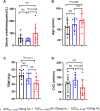Comparative pharmacokinetics of polymyxin B in critically ill elderly patients with extensively drug-resistant gram-negative bacteria infections
- PMID: 38362145
- PMCID: PMC10867212
- DOI: 10.3389/fphar.2024.1347130
Comparative pharmacokinetics of polymyxin B in critically ill elderly patients with extensively drug-resistant gram-negative bacteria infections
Abstract
Introduction: Elderly patients are more prone to develop acute kidney injury during infections and polymyxin B (PMB)-associated nephrotoxicity than young patients. The differential response to PMB between the elderly and young critically ill patients is unknown. We aimed to assess PMB exposure in elderly patients compared with young critically ill patients, and to determine the covariates of PMB pharmacokinetics in critically ill patients. Methods: Seventeen elderly patients (age ≥ 65 years) and six young critically ill patients (age < 65 years) were enrolled. Six to eight blood samples were collected during the 12 h intervals after at least six doses of intravenous PMB in each patient. PMB plasma concentrations were quantified by high-performance liquid chromatography-tandem mass spectrometry. The primary outcome was PMB exposure as assessed by the area under the concentration-time curve over 24 h at steady state (AUCss, 0-24 h). Results and Discussion: The elderly group had lower total body weight (TBW) and higher Charlson comorbidity scores than young group. Neither AUCss, 0-24 h nor normalized AUCss, 0-24 h (adjusting AUC for the daily dose in mg/kg of TBW) was significantly different between the elderly group and young group. The half-life time was longer in the elderly patients than in young patients (11.21 vs 6.56 h respectively, p = 0.003). Age and TBW were the covariates of half-life time (r = 0.415, p = 0.049 and r = -0.489, p = 0.018, respectively). TBW was the covariate of clearance (r = 0.527, p = 0.010) and AUCss, 0-24 h (r = -0.414, p = 0.049). Patients with AUCss, 0-24 h ≥ 100 mg·h/L had higher baseline serum creatinine levels and lower TBW than patients with AUCss, 0-24 h < 50 mg·h/L or patients with AUCss, 0-24 h 50-100 mg·h/L. The PMB exposures were comparable in elderly and young critically ill patients. High baseline serum creatinine levels and low TBW was associated with PMB overdose. Trial registration: ChiCTR2300073896 retrospectively registered on 25 July 2023.
Keywords: critical care; elderly; pharmacokinetics; polymyxin B; renal function; total body weight.
Copyright © 2024 Zeng, Leng, Guan, Jiang, Xie, Zhu, Tang, Zhang, Sha, Wang, Ding, Guo and Jiang.
Conflict of interest statement
The authors declare that the research was conducted in the absence of any commercial or financial relationships that could be construed as a potential conflict of interest.
Figures


Similar articles
-
Biomarker-Driven Pharmacokinetics and Efficacy of Polymyxin B in Critically Ill Patients with XDR-GN Pneumonia.Pharmaceuticals (Basel). 2025 Apr 17;18(4):586. doi: 10.3390/ph18040586. Pharmaceuticals (Basel). 2025. PMID: 40284021 Free PMC article.
-
Population pharmacokinetics of polymyxin B in critically ill patients with carbapenem-resistant organisms infections: insights from steady-state trough and peak plasma concentration.Front Pharmacol. 2025 Mar 12;16:1511088. doi: 10.3389/fphar.2025.1511088. eCollection 2025. Front Pharmacol. 2025. PMID: 40144658 Free PMC article.
-
An area under the concentration-time curve threshold as a predictor of efficacy and nephrotoxicity for individualizing polymyxin B dosing in patients with carbapenem-resistant gram-negative bacteria.Crit Care. 2022 Oct 18;26(1):320. doi: 10.1186/s13054-022-04195-7. Crit Care. 2022. PMID: 36258197 Free PMC article.
-
Does Monitoring Total and Free Polymyxin B1 Plasma Concentrations Predict Polymyxin B-Induced Nephrotoxicity? A Retrospective Study in Critically Ill Patients.Infect Dis Ther. 2022 Aug;11(4):1591-1608. doi: 10.1007/s40121-022-00655-3. Epub 2022 Jun 11. Infect Dis Ther. 2022. PMID: 35689791 Free PMC article.
-
Population pharmacokinetics of polymyxin B: a systematic review.Ann Transl Med. 2022 Feb;10(4):231. doi: 10.21037/atm-22-236. Ann Transl Med. 2022. PMID: 35280373 Free PMC article. Review.
Cited by
-
Risk Factors Associated with Antibiotic Exposure Variability in Critically Ill Patients: A Systematic Review.Antibiotics (Basel). 2024 Aug 24;13(9):801. doi: 10.3390/antibiotics13090801. Antibiotics (Basel). 2024. PMID: 39334976 Free PMC article. Review.
References
LinkOut - more resources
Full Text Sources

